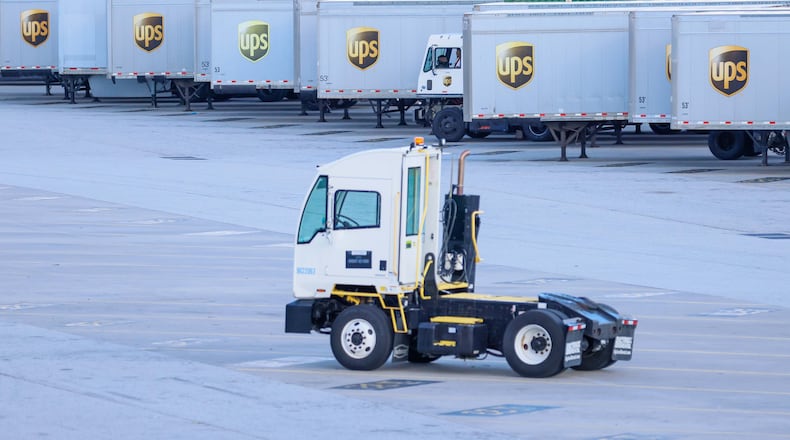Editor’s note: This story has been updated with additional details throughout.
UPS is holding off on confirming its prior annual financial projections “given the current macro-economic uncertainty” facing its customers. It also reported a drop in domestic package volumes in February and March because of dampened consumer demand.
“The world hasn’t been faced with such enormous potential impacts to trade in more than 100 years, so the only thing we’re certain of, is we don’t know which, if any, of our scenarios will play out,” CEO Carol Tomé told investors Tuesday morning.
She insisted, however, that the company is well-positioned to “manage through” the situation.
UPS’ vast logistics network and its observations of customer behavior can serve as a bellwether for the global economy. In 2024, the company delivered an average of 22.4 million packages daily.
The global shipping giant reported Tuesday that an already announced cutback to its relationship with Amazon, combined with a larger push to make its network more “efficient,” will translate into 20,000 lost jobs and the closure of 73 leased and owned buildings by the end of June — with more to come.
A company spokesman declined to answer questions about exactly which buildings would close, but CFO Brian Dykes told investors about two-thirds would be in the eastern part of the United States and one-third in the western.
The lost positions are not only connected to those buildings and will be spread “across the entire U.S. network,” he added. In total, the company expects the changes will cut about $3.5 billion in costs in 2025.
For years, Amazon has been the company’s largest customer. UPS has about 490,000 employees worldwide, meaning the cuts about 4% of its workforce.
The company already cut 12,000 people in its management ranks last year.
‘Many things we don’t know’
Based on conversations with its biggest 100 U.S. customers, Tomé said it remains “an open question” how they are choosing to respond to the tariffs.
Some are already looking to move manufacturing to other countries, some are absorbing the costs, some are increasing prices, and some are looking to suppliers to help absorb the costs, she said.
UPS’ small- and medium-sized business clients, however, are likely to be disproportionately affected by the current trade war, as many are 100% single-sourced from China — and the fact that a tariff exception for packages sent from China to the U.S. valued under $800 is set to end Friday, Tomé said.
These customers aren’t big enough to “pull forward” inventory and stockpile, as larger customers have already done, she noted.
Still, given the trade environment and the penchant of the Trump administration to put actions on pause, she noted the Friday deadline remains clouded. “We know it’s been announced,” she said. “We don’t know actually if it will happen. We don’t know if it will stick. There are many things we don’t know.”
In interviews with 45,000 global and freight forwarding customers, she said, 95% have told UPS they expect to “maintain their current business model,” though some are considering shifting trade location, transportation mode or exiting a business. They’re also letting inventory levels sell off, she said.
The company’s China-to-U.S. trade lanes are its most profitable, Tomé said, and represented 11% of international revenue last year. It expects volume between the countries to drop nearly 25% in the second quarter.
But Kate Gutmann, president of UPS’ international, health care and chain solutions, said the company is already seeing some of that volume shift to other countries, including Thailand, Vietnam and in Europe.
“I would tell you that it’s shifting. It’s already occurring.”
‘Manage through this’
The Sandy Springs-based company said Tuesday an expected decline in quarterly revenue of about 0.7%. It saw a 4.2% increase in quarterly profit, however, compared to 2024 — slightly above the average of analysts’ expectations.
But its dip in domestic package volumes in February in March fellow below its own expectations and traditional demand.
Actions like the Amazon wind down “to reconfigure our network and reduce cost across our business could not be timelier,” Tomé said in a statement.
The company is reworking its entire network, an undertaking that will ultimately close 200 facilities and result in 400 facilities that are “either partially or fully automated,” said Nando Cesarone, UPS’ U.S. president.
UPS has introduced automation into some of its sorting operations, including at its mega Atlanta SMART hub, west of downtown Atlanta.
The company is looking at “many other automatic opportunities,” including robotics for automatic label applications and unloading and loading trailers, Tomé said.
She told investors that UPS’ network is also well-positioned to handle changes in shipping strategy among its customers.
In 2018, for example, when the first Trump administration instituted tariffs on China, UPS saw its China-to-U.S. business decline, she said, but China to the rest of the world increase.
“It all leveled out, and our international business actually grew,” she said. “We will be able just to manage through this.”
About the Author
Keep Reading
The Latest
Featured




